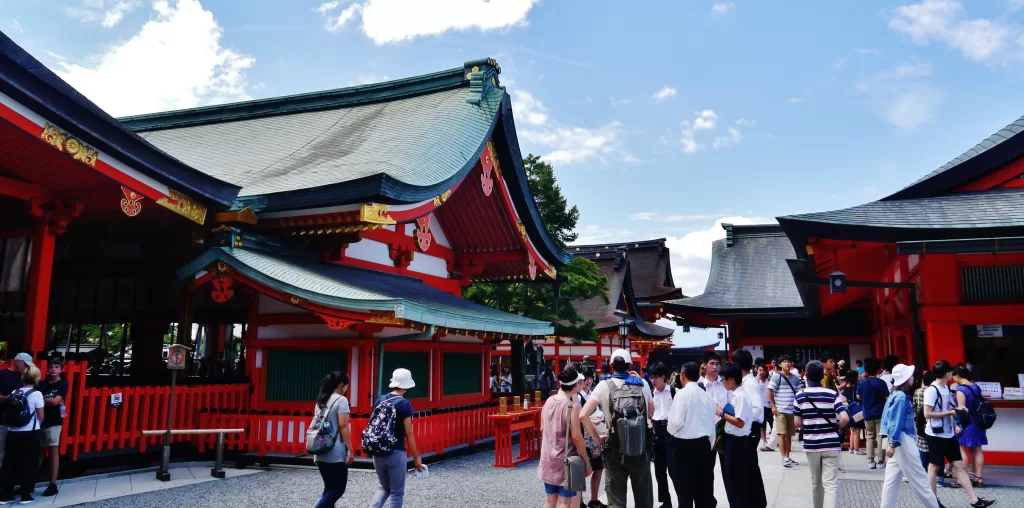Commemorating Annual Hitakisai: The Fire-Festival at Fushimi Inari Shrine

The Ritualistic Significance of Hitakisai
The Hitakisai, also known as the fire building ceremony, is a key ritual that takes place annually in numerous regions across Japan. The most significant event occurring on November 8th each year – no matter what day of the week it happens to fall on – is held at the Fushimi Inari Shrine in Kyoto.
The Hitakisai is a unique tradition where visitors donate their money to the shrine, subsequently writing their names (and/or prayers) on a special goma stick. These goma sticks are then gathered over the months leading up to the bonfire ceremony.
The ceremony itself bears a resemblance to Buddhist goma stick burning ceremonies, which have roots in ancient Indian practices. Within Shinto tradition, visitors’ prayers penned on the goma sticks are offered to deities at the shrine. Priests and priestesses, known as kannushi and miko, respectively, perform purification rites involving applications of essential substances such as salt, water, and sakaki leaves.
Fushimi Inari Shrine: At The Heart Of The Hitakisai
Housing more than 30,000 Inari Shrines around the country, Fushimi Inari proves to be a focal point of attraction for numerous visitors from around Japan every year. The shrine witnesses an influx of people eager to participate specifically in the Ōhitaki Fire Festival.
The first part of the ritual commences with offerings of food and drink made in the honden or main hall while priestesses perform a special kagura dance for the gods. This collective effort towards serving honor also involves a movement away from conventional spots to a clearing. Here, three bonfires are established simultaneously, which further marks an integral part of the ritual.
Sacred rituals and Special Kagura Dances
Fushimi Inari’s Hitaki-sai Fire Festival, one of the most anticipated Kyoto events in November, is marked by dramatic rituals including priests tossing hundreds of thousands prayer sticks into holy bonfires causing flames and smoke to shoot up into the air, symbolizing prayers reaching heavens. As a part of ritualistic proceedings, another set of purification prayers called the Oharae no kotoba (Shinto purification prayers) are recited by all participants leading to an atmosphere charged with a sense of awe and spirituality.
Simultaneously, kagura dances which hold significant importance in Shinto Religion are performed intermittently by priestesses carrying golden bells. These dances continue unbroken until each prayer stick finds its place in the lit-up fires.
Chanelling centuries-old beliefs dating back to the Edo Period (1603-1868), this intricate ceremony purges away sins attributed by individuals and works towards granting wishes written on prayer sticks.

A Blaze that Blends Festivity and Spirituality
Being one of the prominent sights in Kyoto during November each year,Hitaki sai (fire festivals) engage local communities as well as global spectators with its holistic charm centred around faith and festivities. It’s not only about prayer sticks offered by attendees; instead, priests toss large quantities of holy pieces into raging bonfires marking moments filled with spiritual connect alongside unforgettable sights bettering viewer experiences manifold times.
A visually stunning experience marked by towering infernos that last for about an hour at Fushimi Inari Shrine underscores fiery radiance during winter nights starting traditionally from 7th or 8th November according-to traditional 24-season calendar.
Devout attendees patiently wait till around 3pm post-ceremony commencement to collect ashes believed to possess healing properties acted upon by divine powers drawn towards gargantuan flames initiated ceremonially on winters onset.
Such visually rampant yet peaceful rituals invariably call back Inari- ‘the goddess of rice’, convincing her for seasonal rest following harvest much needed before kick-starting agricultural proceedings next year.
Also, if you want to learn more about Kyoto’s rich cultural heritage and experience an elegant and revived ancient tradition, don’t miss out on Kyokusui no Utage.